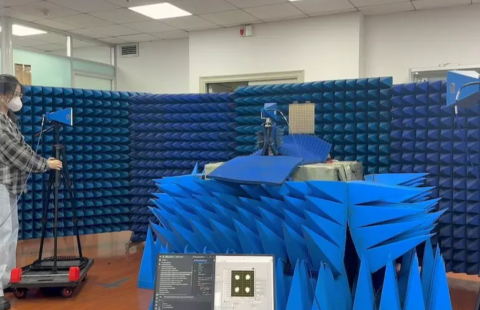Smart Surface Development: UNISANNIO in the International Research Group
International Research Team Develops Innovative Technology to Transform Wireless Networks
A groundbreaking study published in Nature Communications introduces a novel approach to integrating wireless communication and environmental sensing into a single system. The research team, comprising experts from leading global institutions, has engineered a revolutionary surface—known as a spatiotemporal coding metasurface—that could enhance future mobile networks, optimize radar systems, and enable smarter urban and industrial infrastructure.
The study was led by Professors Lei Zhang and Tie Jun Cui from Southeast University, China, in collaboration with Professor Marco Di Renzo (Université Paris-Saclay, CNRS, CentraleSupélec, France, and King’s College London, UK) and Professor Vincenzo Galdi from the University of Sannio, Italy. The research explores how metasurfaces can manipulate wireless signals, enabling them to transmit data while simultaneously detecting objects and movements in their surroundings.
As the world moves towards 6G technology, expected by 2030, wireless networks will undergo a radical transformation—offering speeds up to 100 times faster than current systems, ultra-low latency, and support for applications such as the Internet of Things (IoT), smart cities, and advanced augmented and virtual reality experiences. In this context, the ability to both transmit data and gather environmental information becomes essential.
Emerging applications increasingly demand this dual capability: autonomous vehicles must detect obstacles, smart homes require movement monitoring, and Industry 4.0 relies on real-time process control. Traditionally, communication and sensing have been handled by separate devices, leading to increased costs and complexity. This research addresses this challenge by providing an integrated, efficient solution.
“Imagine if your Wi-Fi router didn’t just provide internet access but could also detect movement, measure distances, and recognize objects in a room,” explains Professor Marco Di Renzo. “Our goal is to develop wireless networks that not only transmit data but also understand and interact with their surroundings, creating an ‘intelligent radio environment.’”
The study introduces an innovative reflective surface capable of dynamically controlling wireless signals. By adjusting the interaction between the surface and the signals in real time, the system ensures reliable communication while simultaneously generating additional signals for environmental sensing. This eliminates the need for extra hardware, making the technology more efficient.
“Think of this surface as a smart mirror that doesn’t just reflect signals but actively modifies them,” explains Professor Vincenzo Galdi. “Each element of the surface contains diodes that can be switched on or off to alter the behavior of electromagnetic waves. These diodes, controlled by an integrated circuit, allow for fully programmable responses. By rapidly changing their activation patterns, we can generate additional signals at various frequencies and precisely control their direction.”
Following theoretical modeling and computer simulations, the researchers developed a working prototype operating at 10.3 GHz, successfully tested in real-world indoor and outdoor environments. The system can also be adapted to different frequencies for specific applications.
“When a signal interacts with the intelligent surface, both the original communication frequency and additional harmonic frequencies for sensing are generated,” adds Professor Lei Zhang. “Using artificial intelligence, the system can track moving users and locate stationary objects, dynamically adapting to its environment. By integrating these smart surfaces into walls, building facades, and other structures, we can transform spaces into interactive and responsive environments. Moreover, the system can balance communication and sensing functions in real time based on contextual needs.”
The convergence of communication and sensing is a cornerstone of 6G, improving spectral efficiency and reducing the need for dedicated hardware. Potential applications range from connected drones and smart home security systems to vehicle-to-infrastructure communication for safer autonomous driving. In healthcare, this technology could revolutionize patient monitoring by providing non-invasive tracking without cameras or wearable devices.
“This research is the result of years of study on wireless signal control materials and new communication paradigms,” concludes Professor Tie Jun Cui. “The interdisciplinary nature of our team has enabled effective integration between electromagnetism and communication theory, paving the way for new applications in the field. Looking ahead, we aim to enhance the efficiency of these intelligent surfaces, integrate artificial intelligence at the system level, and strengthen security measures to protect data and communications from potential threats.”
At the University of Sannio, the research was partially funded by the RESTART program (RESearch and innovation on future Telecommunications systems and networks, to make Italy more smart), the largest publicly funded research and development initiative in the Italian telecommunications sector. Supported by the European Union – NextGenerationEU as part of the National Recovery and Resilience Plan (PNRR), the program has a budget of €116 million and will run for three years, starting in January 2023.
Contact:
Prof. Vincenzo Galdi
Fields & Waves Lab, Department of Engineering
University of Sannio, Benevento
Email: vgaldi@unisannio.it
For more details, refer to the full article published in Nature Communications.
A demonstration video is available at LINK

